MGT502 Assessment 1A: Annotated Bibliography on Virtual Teams
VerifiedAdded on 2022/10/07
|7
|2123
|17
Annotated Bibliography
AI Summary
This annotated bibliography examines the contemporary issue of implementing virtual teams in organizations, presenting ten literary sources. The sources cover a range of topics including team dynamics, leadership, communication, trust, and the impact of technology and globalization on virtual team effectiveness. The articles explore leadership strategies, influence tactics, knowledge sharing, and the challenges of virtual teams, such as cultural and time zone differences. The bibliography includes studies comparing virtual and face-to-face teams, and the role of social, cognitive, and behavioral capabilities in virtual team success. The sources highlight the importance of trust, communication, and leadership in managing diverse, geographically dispersed teams, and discuss the three stages of a virtual workforce. The sources also provide insights into how leaders can overcome cultural, language, and physical barriers in the context of virtual teams.

ANNOTATED BIBLIOGRAHY
Paraphrase This Document
Need a fresh take? Get an instant paraphrase of this document with our AI Paraphraser
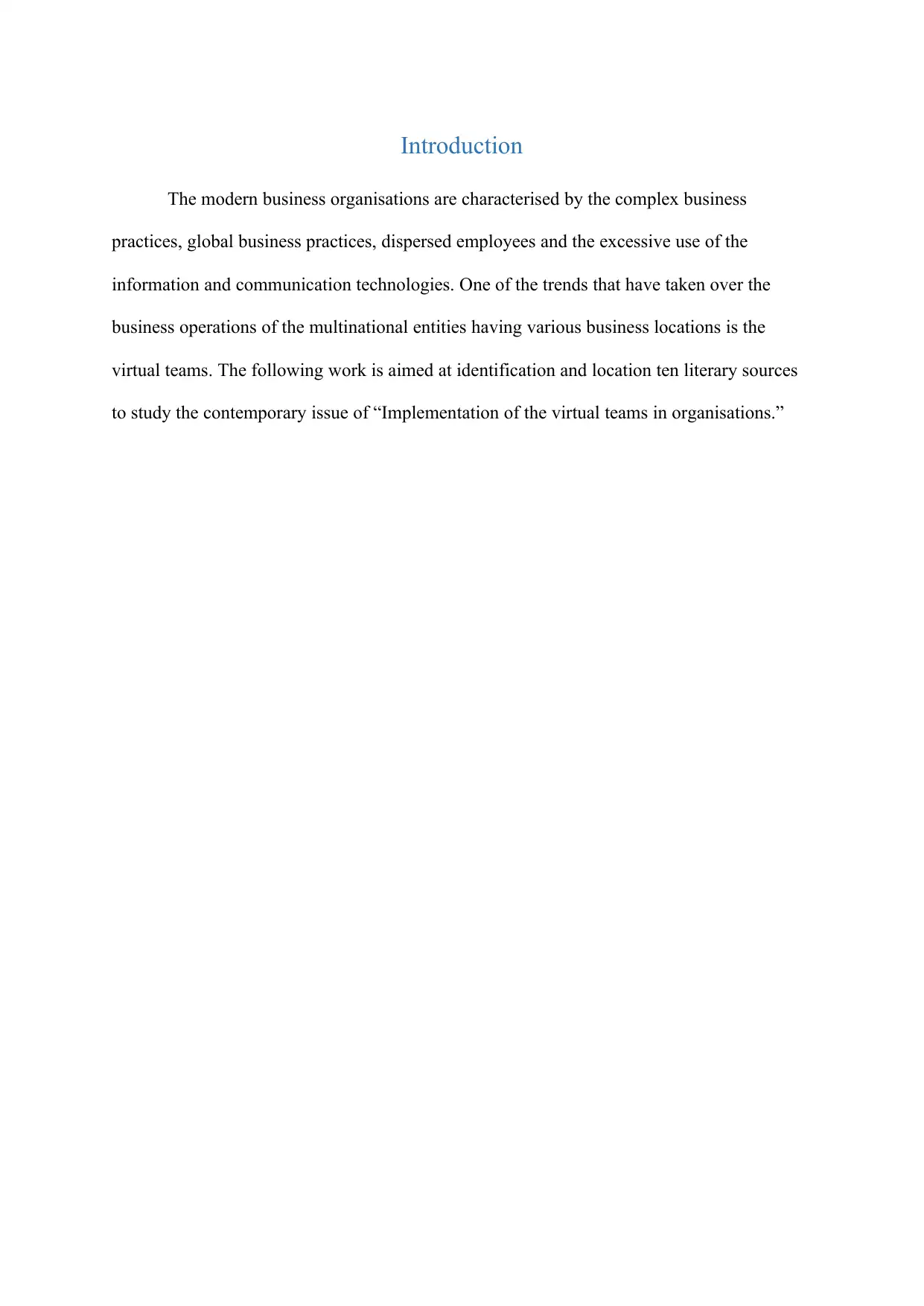
Introduction
The modern business organisations are characterised by the complex business
practices, global business practices, dispersed employees and the excessive use of the
information and communication technologies. One of the trends that have taken over the
business operations of the multinational entities having various business locations is the
virtual teams. The following work is aimed at identification and location ten literary sources
to study the contemporary issue of “Implementation of the virtual teams in organisations.”
The modern business organisations are characterised by the complex business
practices, global business practices, dispersed employees and the excessive use of the
information and communication technologies. One of the trends that have taken over the
business operations of the multinational entities having various business locations is the
virtual teams. The following work is aimed at identification and location ten literary sources
to study the contemporary issue of “Implementation of the virtual teams in organisations.”
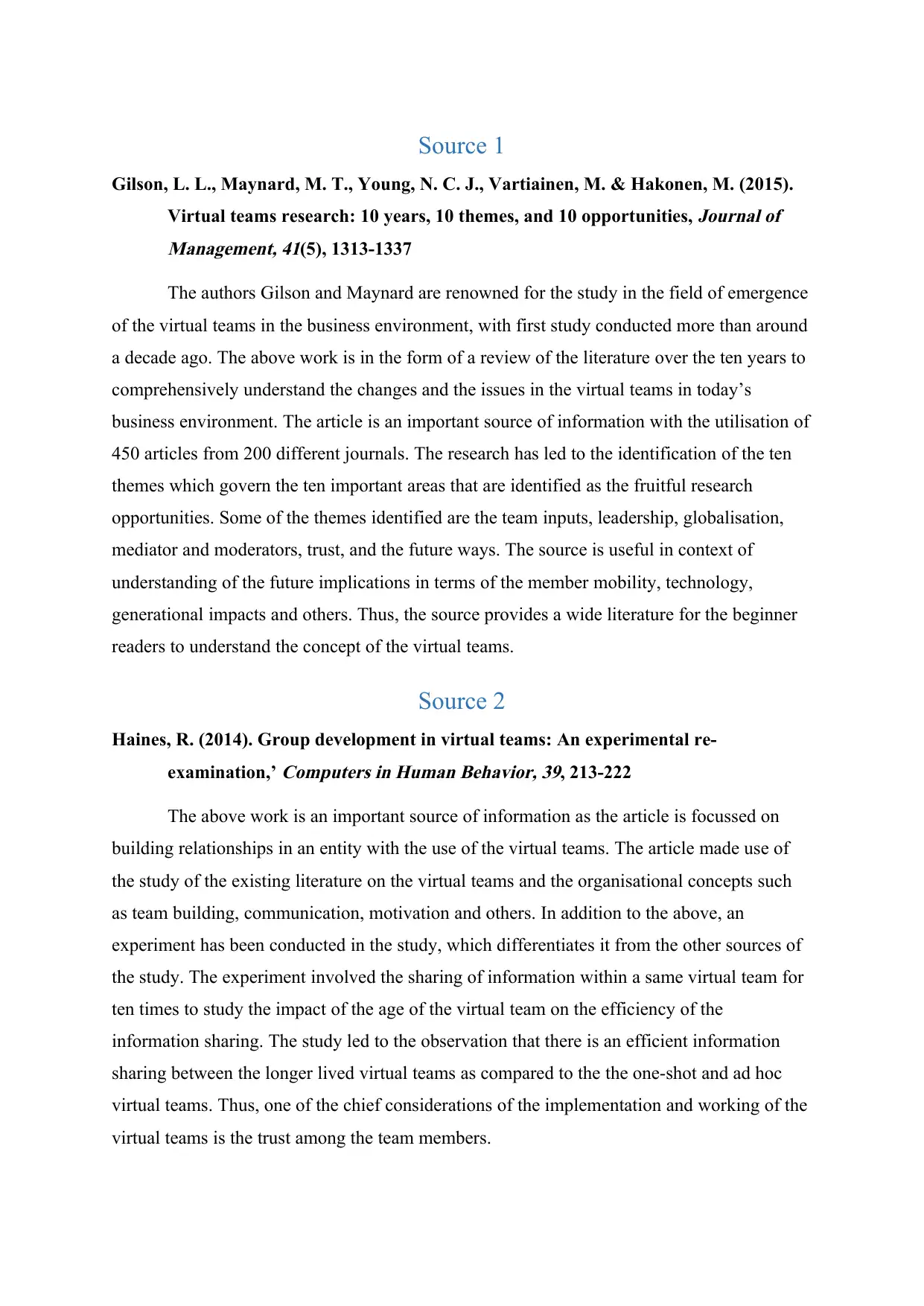
Source 1
Gilson, L. L., Maynard, M. T., Young, N. C. J., Vartiainen, M. & Hakonen, M. (2015).
Virtual teams research: 10 years, 10 themes, and 10 opportunities,
Journal of
Management, 41(5), 1313-1337
The authors Gilson and Maynard are renowned for the study in the field of emergence
of the virtual teams in the business environment, with first study conducted more than around
a decade ago. The above work is in the form of a review of the literature over the ten years to
comprehensively understand the changes and the issues in the virtual teams in today’s
business environment. The article is an important source of information with the utilisation of
450 articles from 200 different journals. The research has led to the identification of the ten
themes which govern the ten important areas that are identified as the fruitful research
opportunities. Some of the themes identified are the team inputs, leadership, globalisation,
mediator and moderators, trust, and the future ways. The source is useful in context of
understanding of the future implications in terms of the member mobility, technology,
generational impacts and others. Thus, the source provides a wide literature for the beginner
readers to understand the concept of the virtual teams.
Source 2
Haines, R. (2014). Group development in virtual teams: An experimental re-
examination,’
Computers in Human Behavior, 39, 213-222
The above work is an important source of information as the article is focussed on
building relationships in an entity with the use of the virtual teams. The article made use of
the study of the existing literature on the virtual teams and the organisational concepts such
as team building, communication, motivation and others. In addition to the above, an
experiment has been conducted in the study, which differentiates it from the other sources of
the study. The experiment involved the sharing of information within a same virtual team for
ten times to study the impact of the age of the virtual team on the efficiency of the
information sharing. The study led to the observation that there is an efficient information
sharing between the longer lived virtual teams as compared to the the one-shot and ad hoc
virtual teams. Thus, one of the chief considerations of the implementation and working of the
virtual teams is the trust among the team members.
Gilson, L. L., Maynard, M. T., Young, N. C. J., Vartiainen, M. & Hakonen, M. (2015).
Virtual teams research: 10 years, 10 themes, and 10 opportunities,
Journal of
Management, 41(5), 1313-1337
The authors Gilson and Maynard are renowned for the study in the field of emergence
of the virtual teams in the business environment, with first study conducted more than around
a decade ago. The above work is in the form of a review of the literature over the ten years to
comprehensively understand the changes and the issues in the virtual teams in today’s
business environment. The article is an important source of information with the utilisation of
450 articles from 200 different journals. The research has led to the identification of the ten
themes which govern the ten important areas that are identified as the fruitful research
opportunities. Some of the themes identified are the team inputs, leadership, globalisation,
mediator and moderators, trust, and the future ways. The source is useful in context of
understanding of the future implications in terms of the member mobility, technology,
generational impacts and others. Thus, the source provides a wide literature for the beginner
readers to understand the concept of the virtual teams.
Source 2
Haines, R. (2014). Group development in virtual teams: An experimental re-
examination,’
Computers in Human Behavior, 39, 213-222
The above work is an important source of information as the article is focussed on
building relationships in an entity with the use of the virtual teams. The article made use of
the study of the existing literature on the virtual teams and the organisational concepts such
as team building, communication, motivation and others. In addition to the above, an
experiment has been conducted in the study, which differentiates it from the other sources of
the study. The experiment involved the sharing of information within a same virtual team for
ten times to study the impact of the age of the virtual team on the efficiency of the
information sharing. The study led to the observation that there is an efficient information
sharing between the longer lived virtual teams as compared to the the one-shot and ad hoc
virtual teams. Thus, one of the chief considerations of the implementation and working of the
virtual teams is the trust among the team members.
⊘ This is a preview!⊘
Do you want full access?
Subscribe today to unlock all pages.

Trusted by 1+ million students worldwide
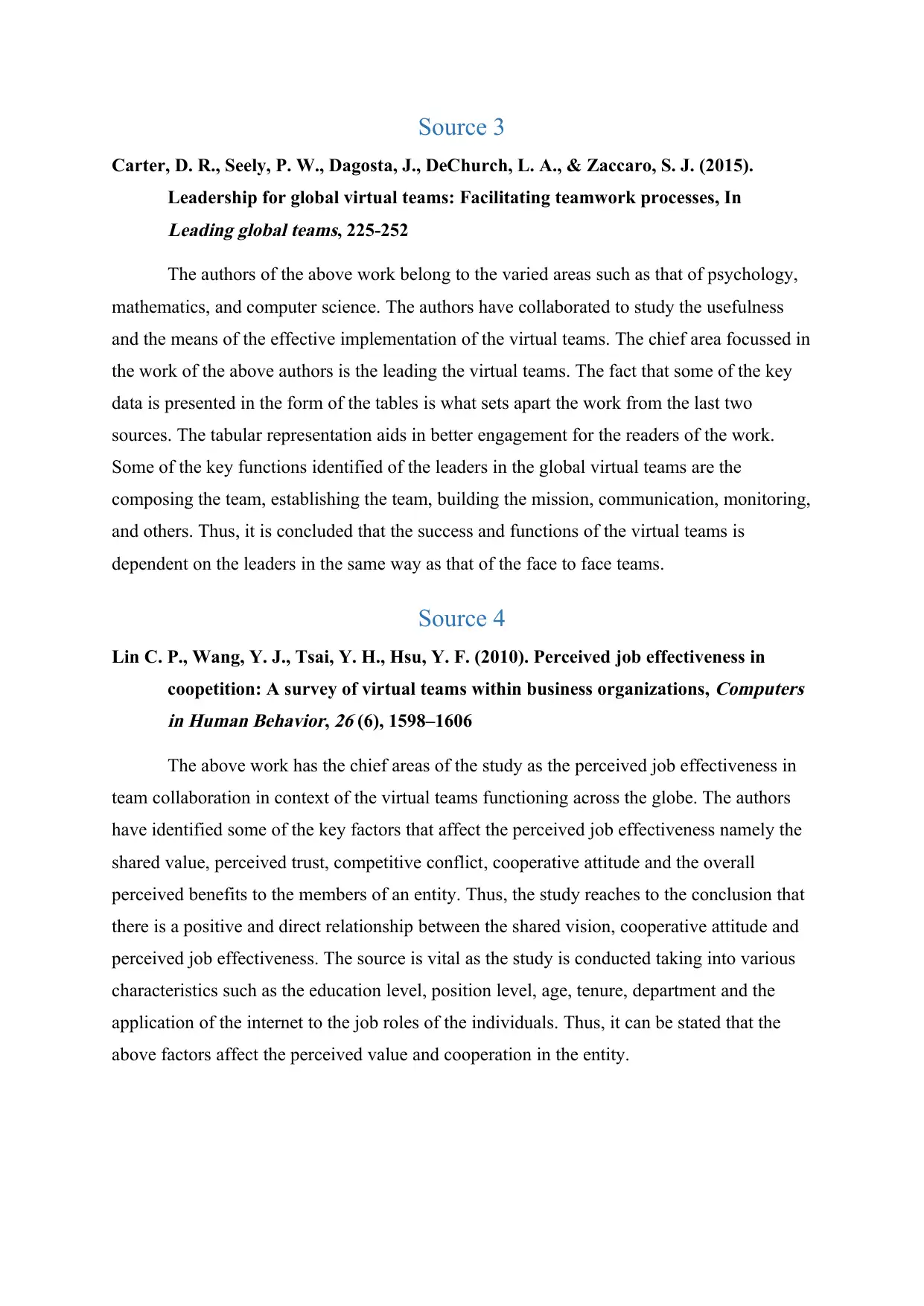
Source 3
Carter, D. R., Seely, P. W., Dagosta, J., DeChurch, L. A., & Zaccaro, S. J. (2015).
Leadership for global virtual teams: Facilitating teamwork processes, In
Leading global teams, 225-252
The authors of the above work belong to the varied areas such as that of psychology,
mathematics, and computer science. The authors have collaborated to study the usefulness
and the means of the effective implementation of the virtual teams. The chief area focussed in
the work of the above authors is the leading the virtual teams. The fact that some of the key
data is presented in the form of the tables is what sets apart the work from the last two
sources. The tabular representation aids in better engagement for the readers of the work.
Some of the key functions identified of the leaders in the global virtual teams are the
composing the team, establishing the team, building the mission, communication, monitoring,
and others. Thus, it is concluded that the success and functions of the virtual teams is
dependent on the leaders in the same way as that of the face to face teams.
Source 4
Lin C. P., Wang, Y. J., Tsai, Y. H., Hsu, Y. F. (2010). Perceived job effectiveness in
coopetition: A survey of virtual teams within business organizations,
Computers
in Human Behavior,
26 (6), 1598–1606
The above work has the chief areas of the study as the perceived job effectiveness in
team collaboration in context of the virtual teams functioning across the globe. The authors
have identified some of the key factors that affect the perceived job effectiveness namely the
shared value, perceived trust, competitive conflict, cooperative attitude and the overall
perceived benefits to the members of an entity. Thus, the study reaches to the conclusion that
there is a positive and direct relationship between the shared vision, cooperative attitude and
perceived job effectiveness. The source is vital as the study is conducted taking into various
characteristics such as the education level, position level, age, tenure, department and the
application of the internet to the job roles of the individuals. Thus, it can be stated that the
above factors affect the perceived value and cooperation in the entity.
Carter, D. R., Seely, P. W., Dagosta, J., DeChurch, L. A., & Zaccaro, S. J. (2015).
Leadership for global virtual teams: Facilitating teamwork processes, In
Leading global teams, 225-252
The authors of the above work belong to the varied areas such as that of psychology,
mathematics, and computer science. The authors have collaborated to study the usefulness
and the means of the effective implementation of the virtual teams. The chief area focussed in
the work of the above authors is the leading the virtual teams. The fact that some of the key
data is presented in the form of the tables is what sets apart the work from the last two
sources. The tabular representation aids in better engagement for the readers of the work.
Some of the key functions identified of the leaders in the global virtual teams are the
composing the team, establishing the team, building the mission, communication, monitoring,
and others. Thus, it is concluded that the success and functions of the virtual teams is
dependent on the leaders in the same way as that of the face to face teams.
Source 4
Lin C. P., Wang, Y. J., Tsai, Y. H., Hsu, Y. F. (2010). Perceived job effectiveness in
coopetition: A survey of virtual teams within business organizations,
Computers
in Human Behavior,
26 (6), 1598–1606
The above work has the chief areas of the study as the perceived job effectiveness in
team collaboration in context of the virtual teams functioning across the globe. The authors
have identified some of the key factors that affect the perceived job effectiveness namely the
shared value, perceived trust, competitive conflict, cooperative attitude and the overall
perceived benefits to the members of an entity. Thus, the study reaches to the conclusion that
there is a positive and direct relationship between the shared vision, cooperative attitude and
perceived job effectiveness. The source is vital as the study is conducted taking into various
characteristics such as the education level, position level, age, tenure, department and the
application of the internet to the job roles of the individuals. Thus, it can be stated that the
above factors affect the perceived value and cooperation in the entity.
Paraphrase This Document
Need a fresh take? Get an instant paraphrase of this document with our AI Paraphraser
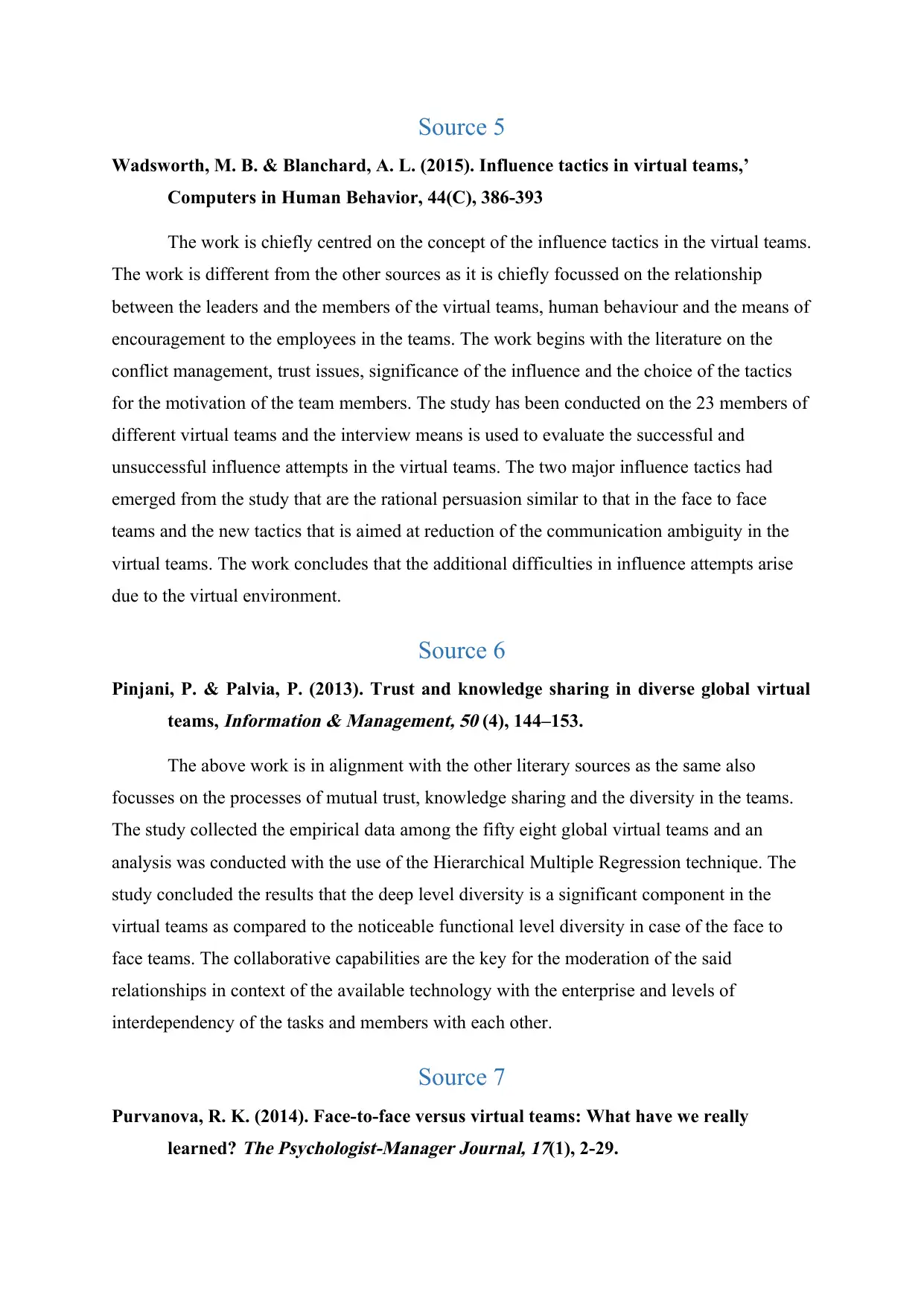
Source 5
Wadsworth, M. B. & Blanchard, A. L. (2015). Influence tactics in virtual teams,’
Computers in Human Behavior, 44(C), 386-393
The work is chiefly centred on the concept of the influence tactics in the virtual teams.
The work is different from the other sources as it is chiefly focussed on the relationship
between the leaders and the members of the virtual teams, human behaviour and the means of
encouragement to the employees in the teams. The work begins with the literature on the
conflict management, trust issues, significance of the influence and the choice of the tactics
for the motivation of the team members. The study has been conducted on the 23 members of
different virtual teams and the interview means is used to evaluate the successful and
unsuccessful influence attempts in the virtual teams. The two major influence tactics had
emerged from the study that are the rational persuasion similar to that in the face to face
teams and the new tactics that is aimed at reduction of the communication ambiguity in the
virtual teams. The work concludes that the additional difficulties in influence attempts arise
due to the virtual environment.
Source 6
Pinjani, P. & Palvia, P. (2013). Trust and knowledge sharing in diverse global virtual
teams,
Information & Management, 50 (4), 144–153.
The above work is in alignment with the other literary sources as the same also
focusses on the processes of mutual trust, knowledge sharing and the diversity in the teams.
The study collected the empirical data among the fifty eight global virtual teams and an
analysis was conducted with the use of the Hierarchical Multiple Regression technique. The
study concluded the results that the deep level diversity is a significant component in the
virtual teams as compared to the noticeable functional level diversity in case of the face to
face teams. The collaborative capabilities are the key for the moderation of the said
relationships in context of the available technology with the enterprise and levels of
interdependency of the tasks and members with each other.
Source 7
Purvanova, R. K. (2014). Face-to-face versus virtual teams: What have we really
learned?
The Psychologist-Manager Journal, 17(1), 2-29.
Wadsworth, M. B. & Blanchard, A. L. (2015). Influence tactics in virtual teams,’
Computers in Human Behavior, 44(C), 386-393
The work is chiefly centred on the concept of the influence tactics in the virtual teams.
The work is different from the other sources as it is chiefly focussed on the relationship
between the leaders and the members of the virtual teams, human behaviour and the means of
encouragement to the employees in the teams. The work begins with the literature on the
conflict management, trust issues, significance of the influence and the choice of the tactics
for the motivation of the team members. The study has been conducted on the 23 members of
different virtual teams and the interview means is used to evaluate the successful and
unsuccessful influence attempts in the virtual teams. The two major influence tactics had
emerged from the study that are the rational persuasion similar to that in the face to face
teams and the new tactics that is aimed at reduction of the communication ambiguity in the
virtual teams. The work concludes that the additional difficulties in influence attempts arise
due to the virtual environment.
Source 6
Pinjani, P. & Palvia, P. (2013). Trust and knowledge sharing in diverse global virtual
teams,
Information & Management, 50 (4), 144–153.
The above work is in alignment with the other literary sources as the same also
focusses on the processes of mutual trust, knowledge sharing and the diversity in the teams.
The study collected the empirical data among the fifty eight global virtual teams and an
analysis was conducted with the use of the Hierarchical Multiple Regression technique. The
study concluded the results that the deep level diversity is a significant component in the
virtual teams as compared to the noticeable functional level diversity in case of the face to
face teams. The collaborative capabilities are the key for the moderation of the said
relationships in context of the available technology with the enterprise and levels of
interdependency of the tasks and members with each other.
Source 7
Purvanova, R. K. (2014). Face-to-face versus virtual teams: What have we really
learned?
The Psychologist-Manager Journal, 17(1), 2-29.
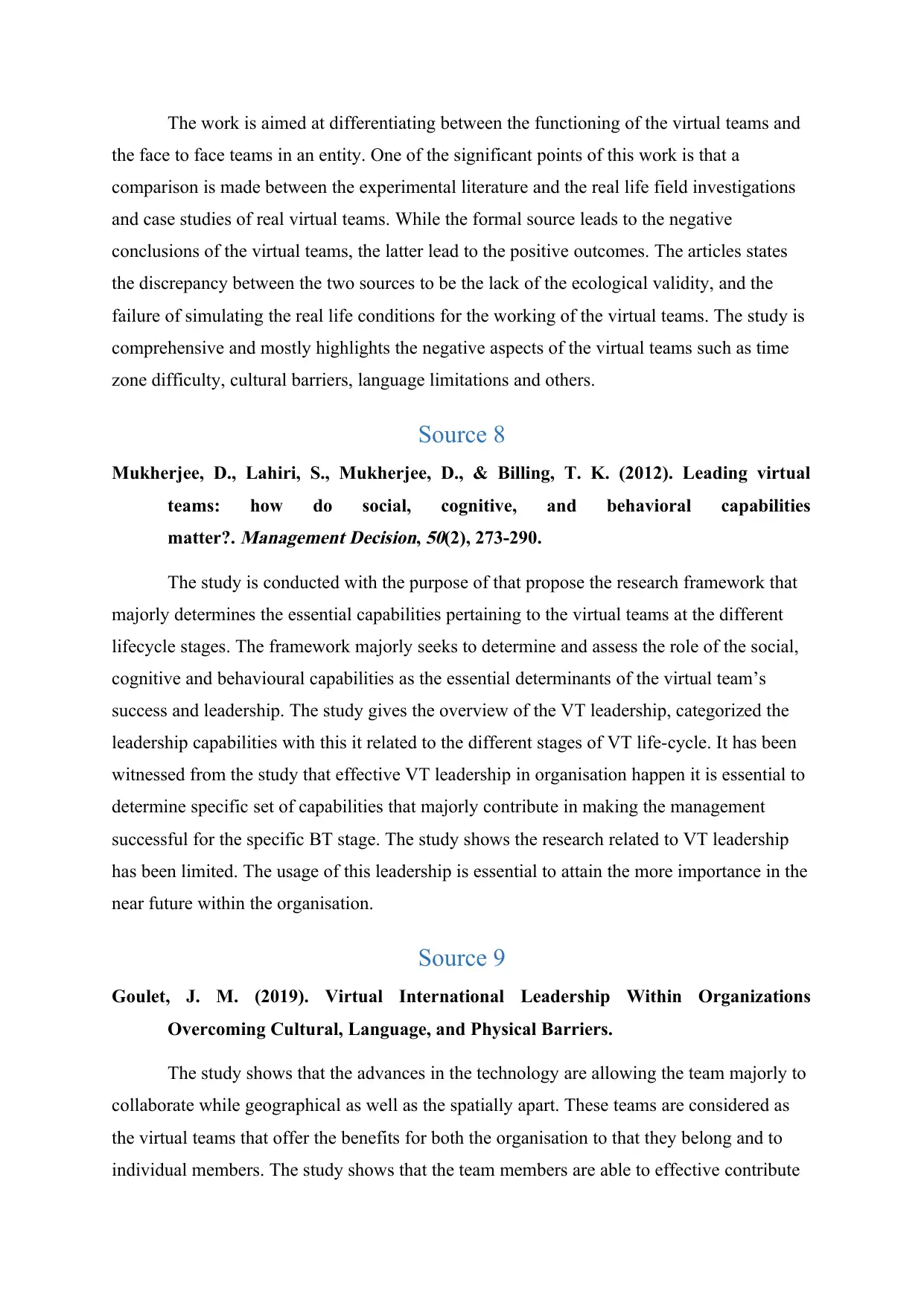
The work is aimed at differentiating between the functioning of the virtual teams and
the face to face teams in an entity. One of the significant points of this work is that a
comparison is made between the experimental literature and the real life field investigations
and case studies of real virtual teams. While the formal source leads to the negative
conclusions of the virtual teams, the latter lead to the positive outcomes. The articles states
the discrepancy between the two sources to be the lack of the ecological validity, and the
failure of simulating the real life conditions for the working of the virtual teams. The study is
comprehensive and mostly highlights the negative aspects of the virtual teams such as time
zone difficulty, cultural barriers, language limitations and others.
Source 8
Mukherjee, D., Lahiri, S., Mukherjee, D., & Billing, T. K. (2012). Leading virtual
teams: how do social, cognitive, and behavioral capabilities
matter?.
Management Decision,
50(2), 273-290.
The study is conducted with the purpose of that propose the research framework that
majorly determines the essential capabilities pertaining to the virtual teams at the different
lifecycle stages. The framework majorly seeks to determine and assess the role of the social,
cognitive and behavioural capabilities as the essential determinants of the virtual team’s
success and leadership. The study gives the overview of the VT leadership, categorized the
leadership capabilities with this it related to the different stages of VT life-cycle. It has been
witnessed from the study that effective VT leadership in organisation happen it is essential to
determine specific set of capabilities that majorly contribute in making the management
successful for the specific BT stage. The study shows the research related to VT leadership
has been limited. The usage of this leadership is essential to attain the more importance in the
near future within the organisation.
Source 9
Goulet, J. M. (2019). Virtual International Leadership Within Organizations
Overcoming Cultural, Language, and Physical Barriers.
The study shows that the advances in the technology are allowing the team majorly to
collaborate while geographical as well as the spatially apart. These teams are considered as
the virtual teams that offer the benefits for both the organisation to that they belong and to
individual members. The study shows that the team members are able to effective contribute
the face to face teams in an entity. One of the significant points of this work is that a
comparison is made between the experimental literature and the real life field investigations
and case studies of real virtual teams. While the formal source leads to the negative
conclusions of the virtual teams, the latter lead to the positive outcomes. The articles states
the discrepancy between the two sources to be the lack of the ecological validity, and the
failure of simulating the real life conditions for the working of the virtual teams. The study is
comprehensive and mostly highlights the negative aspects of the virtual teams such as time
zone difficulty, cultural barriers, language limitations and others.
Source 8
Mukherjee, D., Lahiri, S., Mukherjee, D., & Billing, T. K. (2012). Leading virtual
teams: how do social, cognitive, and behavioral capabilities
matter?.
Management Decision,
50(2), 273-290.
The study is conducted with the purpose of that propose the research framework that
majorly determines the essential capabilities pertaining to the virtual teams at the different
lifecycle stages. The framework majorly seeks to determine and assess the role of the social,
cognitive and behavioural capabilities as the essential determinants of the virtual team’s
success and leadership. The study gives the overview of the VT leadership, categorized the
leadership capabilities with this it related to the different stages of VT life-cycle. It has been
witnessed from the study that effective VT leadership in organisation happen it is essential to
determine specific set of capabilities that majorly contribute in making the management
successful for the specific BT stage. The study shows the research related to VT leadership
has been limited. The usage of this leadership is essential to attain the more importance in the
near future within the organisation.
Source 9
Goulet, J. M. (2019). Virtual International Leadership Within Organizations
Overcoming Cultural, Language, and Physical Barriers.
The study shows that the advances in the technology are allowing the team majorly to
collaborate while geographical as well as the spatially apart. These teams are considered as
the virtual teams that offer the benefits for both the organisation to that they belong and to
individual members. The study shows that the team members are able to effective contribute
⊘ This is a preview!⊘
Do you want full access?
Subscribe today to unlock all pages.

Trusted by 1+ million students worldwide
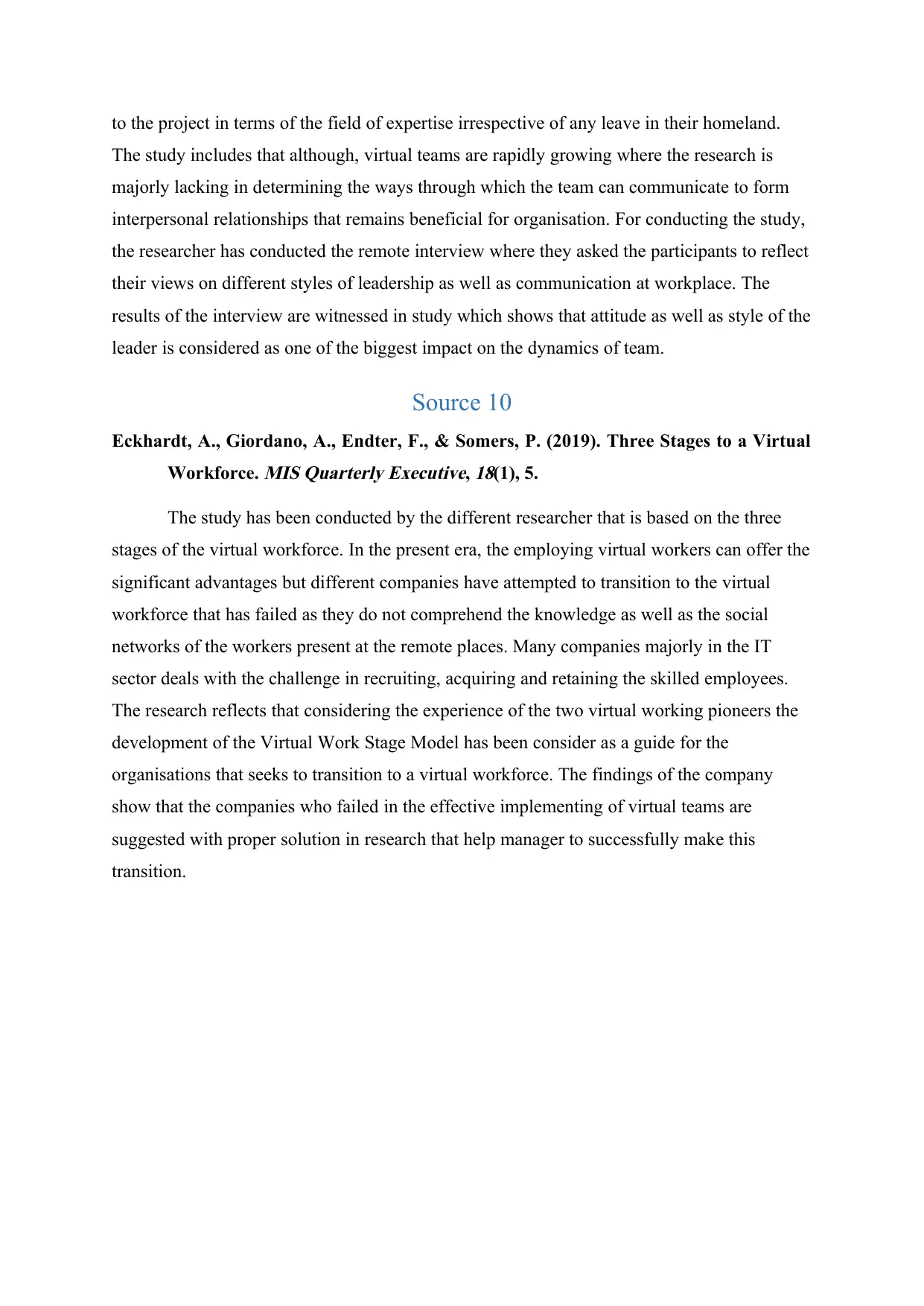
to the project in terms of the field of expertise irrespective of any leave in their homeland.
The study includes that although, virtual teams are rapidly growing where the research is
majorly lacking in determining the ways through which the team can communicate to form
interpersonal relationships that remains beneficial for organisation. For conducting the study,
the researcher has conducted the remote interview where they asked the participants to reflect
their views on different styles of leadership as well as communication at workplace. The
results of the interview are witnessed in study which shows that attitude as well as style of the
leader is considered as one of the biggest impact on the dynamics of team.
Source 10
Eckhardt, A., Giordano, A., Endter, F., & Somers, P. (2019). Three Stages to a Virtual
Workforce.
MIS Quarterly Executive,
18(1), 5.
The study has been conducted by the different researcher that is based on the three
stages of the virtual workforce. In the present era, the employing virtual workers can offer the
significant advantages but different companies have attempted to transition to the virtual
workforce that has failed as they do not comprehend the knowledge as well as the social
networks of the workers present at the remote places. Many companies majorly in the IT
sector deals with the challenge in recruiting, acquiring and retaining the skilled employees.
The research reflects that considering the experience of the two virtual working pioneers the
development of the Virtual Work Stage Model has been consider as a guide for the
organisations that seeks to transition to a virtual workforce. The findings of the company
show that the companies who failed in the effective implementing of virtual teams are
suggested with proper solution in research that help manager to successfully make this
transition.
The study includes that although, virtual teams are rapidly growing where the research is
majorly lacking in determining the ways through which the team can communicate to form
interpersonal relationships that remains beneficial for organisation. For conducting the study,
the researcher has conducted the remote interview where they asked the participants to reflect
their views on different styles of leadership as well as communication at workplace. The
results of the interview are witnessed in study which shows that attitude as well as style of the
leader is considered as one of the biggest impact on the dynamics of team.
Source 10
Eckhardt, A., Giordano, A., Endter, F., & Somers, P. (2019). Three Stages to a Virtual
Workforce.
MIS Quarterly Executive,
18(1), 5.
The study has been conducted by the different researcher that is based on the three
stages of the virtual workforce. In the present era, the employing virtual workers can offer the
significant advantages but different companies have attempted to transition to the virtual
workforce that has failed as they do not comprehend the knowledge as well as the social
networks of the workers present at the remote places. Many companies majorly in the IT
sector deals with the challenge in recruiting, acquiring and retaining the skilled employees.
The research reflects that considering the experience of the two virtual working pioneers the
development of the Virtual Work Stage Model has been consider as a guide for the
organisations that seeks to transition to a virtual workforce. The findings of the company
show that the companies who failed in the effective implementing of virtual teams are
suggested with proper solution in research that help manager to successfully make this
transition.
1 out of 7
Related Documents
Your All-in-One AI-Powered Toolkit for Academic Success.
+13062052269
info@desklib.com
Available 24*7 on WhatsApp / Email
![[object Object]](/_next/static/media/star-bottom.7253800d.svg)
Unlock your academic potential
Copyright © 2020–2025 A2Z Services. All Rights Reserved. Developed and managed by ZUCOL.





